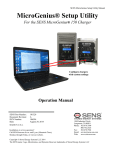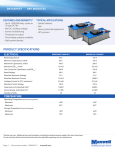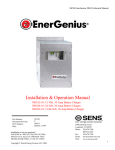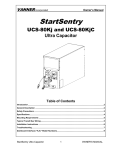Download MicroGenius ® 150 Quick Start Guide
Transcript
Getting Started 1. Mount The Charger SEE MOUNTING HOLE TEMPLATES ON REVERSE SIDE 6” (152 mm) INSTALL OPEN-FRAME CHARGER IN AN ENCLOSURE SUITABLE FOR THE PROTECTION OF PERSONNEL AND WATER INGRESS INTO THE EQUIPMENT ADEQUATE AIR FLOW IMPORTANT! INSTALL MOUNTING HARDWARE BEFORE CONNECTING WIRING 2” (51 mm) PROTECT ENCLOSED CHARGER FROM DRIVING LIQUID, RAIN, SNOW INSTALL VERTICALLY IN WELL-VENTILATED AREA 2” (51 mm) 2. Configure Battery Settings IMPORTANT! SET FLOAT VOLTAGE ENABLE BOOST ENABLE BOOST Use NORM setting for most flooded batteries and OFF for VRLA batteries CONFIGURE CHARGER USING JUMPERS BEFORE CONNECTING WIRING ENABLE BOOST and SET FLOAT VOLTAGE Check battery manufacturer specifications to determine best settings BOOST ENABLE ULTRACAPACITOR Place jumpers in both the BOOST NORM and BOOST HIGH positions and remove FLOAT setting jumper to enable operation with ultracapacitors FOR CHARGER TO PROVIDE OUTPUT A JUMPER MUST BE PLACED FOR EACH SETTING FLOAT SELECT 12V OR 24V BATTERY/ ULTRACAP RANGE HIGH NORM OFF 14.3/28.6 13.5/27.0 13.3/26.6 12V 24V NOTE! (BATTERIES ONLY) 3. Make Electrical Connections OPTIONAL - J1939 SETTING & CONNECTIONS (IF SUPPORTED BY GENSET CONTROLLER) COM OKAY FAIL COM 2 3 4 5 6 7 8 OKAY FAIL 1 COM OKAY 5 OPTIONAL CONNECT ALARM WIRES AT TB5 OUTPUT FAIL FAIL COM 4 OKAY FAIL 3 COM CAN PWR 2 FAIL CAN H 1 CHARGER FAIL OKAY SHIELD LOW DC CAN L TERM HIGH DC CAN GND ADDR AC LINE 9 10 11 12 13 14 15 FLOAT HIGH NORM OFF 14.3/28.6 13.5/27.0 13.3/26.6 12V 24V BOOST RANGE L1 L2/N GND AC SOURCE DISCONNECTED 100 - 240VAC 50/60HZ CONNECT AC WIRES AT TB1 TEMPERATURE SENSOR AT TB2 CONNECT DC WIRES AT TB3 BATTERY OR ULTRACAP DISCONNECTED 4. Powering On - Double-check wiring before powering charger! STEP 1 CONNECT AC SOURCE 100 - 240VAC 50/60HZ STEP 2 MicroGenius 150 High Performance Battery Charger AC AC AC Good AC Fail GREEN RED Invalid Setting YELLOW DC GREEN RED YELLOW RED + YELLOW YELLOW DC DC Good Charger Fail DC Voltage Low or High Battery Backwards Invalid Setting ADDITIONAL LED CODES LOCATED IN USER MANUAL ALARM CONNECTIONS CLOSE BATTERY BATTERY/ULTRACAP DISCONNECT OR CONNECT BATTERY IMPORTANT! NEVER CONNECT AN ULTRACAPACITOR AND BATTERY DIRECTLY IN PARALLEL Need Help? REFER TO THE USER MANUAL OR CONTACT SENS CUSTOMER SERVICE: 800-742-2326 / 303-678-7500 / [email protected] USE YOUR SMART PHONE QR CODE READER TO ACCESS USER MANUAL Mounting Template IMPORTANT SAFETY INSTRUCTIONS 10.2 1. SAVE THESE INSTRUCTIONS –This guide contains important safety and operating instructions for MicroGenius®150 battery chargers. Have plenty of fresh water and soap nearby in case battery electrolyte contacts skin, clothing, or eyes. 10.3 Wear complete eye protection and clothing protection. Avoid touching eyes while working near a storage battery. 10.4 If battery electrolyte contacts skin or clothing, wash immediately with soap and water. If electrolyte enters eye, immediately flood the eye with running cold water for at least 10 minutes and get medical attention immediately. 10.5 NEVER smoke or allow a spark or flame in vicinity of battery, ultracap or engine. 10.6 Be extra cautious to reduce risk of dropping a metal tool onto battery/ultracap. It might spark or short circuit battery/ultracap or other electrical part that may cause explosion. Using insulated tools reduces this risk, but will not eliminate it. 10.7 Remove personal metal items such as rings, bracelets, necklaces, and watches when working with a storage battery/ultracap. A storage battery/ultracap can produce a short circuit current high enough to weld a ring or the like to metal, causing a severe burn. 10.8 When charging batteries, charge 6 and 12 cell LEAD-ACID or 10 and 20 cell LIQUID ELECTROLYTE NICKEL-CADMIUM batteries only, with rated capacity of 30 to 120 Ampere hours. Do not use this battery charger to supply power to an extra-low voltage electrical system or to charge any type of non-rechargeable, dry cell, alkaline, lithium, nickel-metal-hydride, or sealed nickel-cadmium batteries that are commonly used with home appliances. These batteries may burst and cause injuries to persons and damage to property. 10.9 NEVER charge a frozen battery. 2. Do not expose charger to rain or snow. 3. Use of an attachment not recommended or sold by the battery charger manufacturer may result in a risk of fire, electric shock, or injury to persons. 4. This charger is intended for commercial and industrial use. ONLY TRAINED AND QUALIFIED PERSONNEL MAY INSTALL AND SERVICE THIS UNIT. 5. Do not operate charger if it has received a sharp blow, been dropped, or otherwise damaged in any way; shut off power at the branch circuit protectors and have the unit serviced or replaced by qualified personnel. 6. To reduce risk of electric shock, disconnect the branch circuit feeding the charger before attempting any maintenance or cleaning. Turning off controls will not reduce this risk. 7. This equipment is compliant with Class A of CISPR 16. In a residential environment, this equipment may cause radio interference. 8. WARNING – RISK OF EXPLOSIVE GASES 8.1 WORKING IN THE VICINITY OF A LEAD-ACID OR NICKEL-CADMIUM BATTERY IS DANGEROUS. STORAGE BATTERIES GENERATE EXPLOSIVE GASES DURING NORMAL BATTERY OPERATION. FOR THIS REASON, IT IS OF UTMOST IMPORTANCE THAT YOU READ THIS MANUAL AND FOLLOW THE INSTRUCTIONS EACH TIME YOU USE THE CHARGER. 8.2 To reduce the risk battery explosion, follow these instructions and those published by the battery manufacturer and the manufacturer of any equipment you intend to use in the vicinity of a battery. Review cautionary markings on these products and on the engine. 9. WARNING – RISK OF SHOCK 9.1 ULTRACAPACITORS ACCEPT AND DISCHARGE CURRENT RAPIDLY. NEVER ATTEMPT TO JUMP OR CONNECT A BATTERY TO AN ULTRACAPACITOR. 10. PERSONAL PRECAUTIONS 10.1 Someone should be within range of your voice or close enough to come to your aid when you work near a storage battery or ultracapacitor. 10.10 The charger contains a DC output fuse for internal fault protection, but this will not protect the DC wiring from fault currents available from the battery./ultracap Consult national and local ordinances to determine if additional battery fault protection is necessary in your installation. 10.11 Study all battery/ultracap manufacturer specific precautions such as removing or not removing cell caps while charging and recommended rate of charge. 10.12 Do not operate charger in a closed-in area or restrict ventilation in any way. 10.13 Never place the charger directly above or below the battery being charged; gases from the battery will corrode and damage charger. Locate the charger as far away from the battery as DC cables permit. 3.50” (88.9mm) ENCLOSED CHASSIS (MODELS GXX-XX-LXX) USE SOLID LINE MOUNTING HOLES OPEN-FRAME CHASSIS (MODELS GXX-XX-RXX) USE DASHED LINE MOUNTING HOLES 7.75” (196.9mm) 7.25” (184.2mm) = 4 x open-frame chassis mounting, 0.22” diameter holes = 4 x enclosed chassis mounting, 0.26” diameter holes For information and service on any SENS product, please contact us at: Sales 1.866.736.7872 • 303.678.7500 • Fax 303.678.7504 • www.sens-usa.com • [email protected] Stored Energy Systems, LLC 1840 Industrial Circle, Longmont, CO 80501 USA 101318 Rev D Date Issued: 9/21/15







